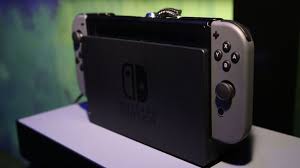Some Four Things you should consider getting for your Nintendo Switch before its Arrival
March 3rd,
2017 is the official launch date of the Nintendo Switch. While you have your consoles’
preorder locked, there are a few other things you might want to grab for your
Switch in advance. So you need to check them out.
Below are
four things you should consider getting for your Nintendo Switch before it comes
in; for microSD cards, Ethernet adapters, charging cables, and everything else that
you might want on hand when your Switch arrives.
MICROSD
CARDS
The Nintendo
Switch can theoretically take use microSD cards up to 2TB (although 256GB cards
are the largest size currently on the market). When choosing your storage,
remember that microSD cards aren’t created equal, and there’s a lot more to
their specs than pure storage capacity.
USE WHAT YOU
HAVE:
Obviously,
the best memory card for your Switch is probably the one you already have at
home. The Switch is compatible with SDXC cards, which is backwards compatible
with the older, smaller capacity SD and SDHC cards. So pretty much any microSD
card you’ve got lying around from an old Android phone or a digital camera
should work in the Switch. You’ll have to format and erase the contents of the
card before using it, so back up anything you’d like to keep first.
OR GET A NEW
ONE:
If you’re
looking to buy a new card specifically for the Switch, we have some
recommendations for that, too. Now, Nintendo hasn’t released the exact
specifications for the Switch’s SD card support beyond the 2TB and SDXC
details. That said, the company is licensing accessory maker Hori to make
bespoke Nintendo Switch-branded cards, so we’ll use those specifications, for
the time being, as our guideline as to what class of microSD card to look for.
The Hori card is a smaller microSDHC card,
storage-wise, but we care about the speeds: it’s a UHS-I slot (denoted by the
Roman numeral I) with a Class 10 speed class (the 10 in the circle) and Class 1
UHS Speed Class (the 1 in the u-shaped bucket). We’ve contacted Nintendo for
more details, but until we hear otherwise, we’ll be focusing on cards with
roughly those parameters.
If you want
the best card, with the fastest speeds, and the most storage, then you will
want the 256GB Samsung Evo+. It runs for around $160 on Amazon, and ticks all
the speed boxes (and then some) for the Switch. Alternatively, Microdia
theoretically sells a 512GB microSD card, but it’ll cost you a cool $1,000.
USB-C CABLES
The Switch
comes with an USB-C charger that connects directly to the console or to the
dock. But if you’re planning on charging up your console on away from your TV
and an electric socket, it will help have a few extra USB-C cables.
Anker’s USB
Type-A to USB-C cables are cheap and reliable enough that you shouldn’t have to
worry about frying your new console. Alternatively, you can grab some $7 microUSB
adapters and repurpose some of your existing cables instead. And if you’ve
already fully made the jump to USB-C, grab a spare USB-C to USB-C cable.
CASE
The Switch’s
biggest selling point is the ability to take it with you on the go. To that
end, you’ll probably want a case. There’s a whole bunch of options already up
for preorder online, but without trying any of them out, it’s hard to say for
sure what’s good. That said, PDP’s $15 option looks like it should get the job
done for basic protection of your new console. The fact that it isn’t an
eyesore helps.
ETHERNET
ADAPTER
If you’re
planning on connecting your Switch to the internet through Ethernet, you’ll
need a USB adapter to use with the Switch dock. Nintendo has its own $30
branded one, but you’ll probably want to skip that and just use a cheaper
option instead.



Comments